
The California Department of Transportation (Caltrans) is an executive department of the U.S. state of California. The department is part of the cabinet-level California State Transportation Agency (CalSTA). Caltrans is headquartered in Sacramento.
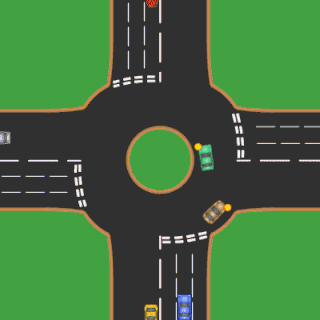
A roundabout, also known as a rotary or traffic circle, is a type of circular intersection or junction in which road traffic is permitted to flow in one direction around a central island, and priority is typically given to traffic already in the junction.

An intersection or an at-grade junction is a junction where two or more roads converge, diverge, meet or cross at the same height, as opposed to an interchange, which uses bridges or tunnels to separate different roads. Major intersections are often delineated by gores and may be classified by road segments, traffic controls and lane design.

The El Toro "Y" is a freeway interchange in southern Orange County, California where the Santa Ana Freeway, Interstate 5 (I-5), and the San Diego Freeway merge. South of the El Toro Y, the highway is named the "San Diego Freeway" with the highway designation "I-5." Located in south Orange County where the cities of Lake Forest, Laguna Hills, and Irvine converge, the interchange was named after the nearby city and the now-closed Marine Corps Air Station El Toro, located northeast of the interchange.

State Route 99 (SR 99) is a north–south state highway in the U.S. state of California, stretching almost the entire length of the Central Valley. From its southern end at Interstate 5 (I-5) near Wheeler Ridge to its northern end at SR 36 near Red Bluff, SR 99 goes through the densely populated eastern parts of the valley. Cities served include Bakersfield, Delano, Tulare, Visalia, Fresno, Madera, Merced, Turlock, Modesto, Manteca, Stockton, Sacramento, Yuba City, and Chico.
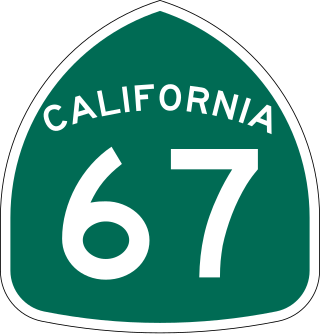
State Route 67 (SR 67) is a state highway in San Diego County, California, United States. It begins at Interstate 8 (I-8) in El Cajon and continues to Lakeside as the San Vicente Freeway before becoming an undivided highway through the eastern part of Poway. In the town of Ramona, the route turns into Main Street before ending at SR 78. SR 67 provides direct access from the city of San Diego to the East County region of San Diego County, including Ramona and Julian.

In civil engineering, grade separation is a method of aligning a junction of two or more surface transport axes at different heights (grades) so that they will not disrupt the traffic flow on other transit routes when they cross each other. The composition of such transport axes does not have to be uniform; it can consist of a mixture of roads, footpaths, railways, canals, or airport runways. Bridges, tunnels, or a combination of both can be built at a junction to achieve the needed grade separation.
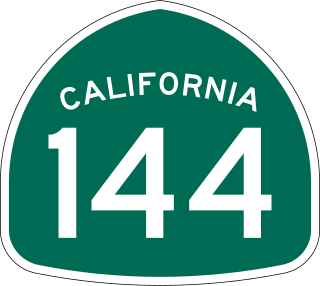
State Route 144 is a state highway in the U.S. state of California that runs through the Sycamore Canyon in Santa Barbara. It travels along Sycamore Canyon Road from its intersection with Alameda Padre Serra at the Five Points Roundabout to Stanwood Drive.

A partial cloverleaf interchange or parclo is a modification of a cloverleaf interchange.

State Route 39 is a state highway in the U.S. state of California that travels through Orange and Los Angeles counties. Its southern terminus is at Pacific Coast Highway, in Huntington Beach. SR 39's northern terminus is at Islip Saddle on Angeles Crest Highway in the Angeles National Forest, but its northernmost 4.5-mile (7.2 km) segment has been closed to public highway traffic since 1978 due to a massive mud and rockslide.
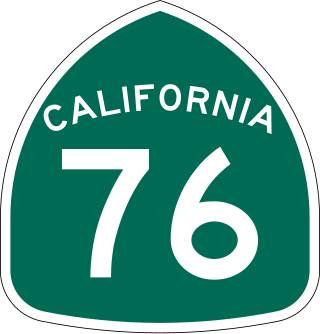
State Route 76 (SR 76) is a state highway 52.63 miles (84.70 km) long in the U.S. state of California. It is a much used east–west route in the North County region of San Diego County that begins in Oceanside near Interstate 5 (I-5) and continues east. The highway is a major route through the region, passing through the community of Bonsall and providing access to Fallbrook. East of the junction with I-15, SR 76 goes through Pala and Pauma Valley before terminating at SR 79.

In the field of road transport, an interchange or a grade-separated junction is a road junction that uses grade separations to allow for the movement of traffic between two or more roadways or highways, using a system of interconnecting roadways to permit traffic on at least one of the routes to pass through the junction without interruption from crossing traffic streams. It differs from a standard intersection, where roads cross at grade. Interchanges are almost always used when at least one road is a controlled-access highway or a limited-access divided highway (expressway), though they are sometimes used at junctions between surface streets.

TRL Limited, trading as TRL is an independent private company offering a transport consultancy and research service to the public and private sector. Originally established in 1933 by the UK Government as the Road Research Laboratory (RRL), it was privatised in 1996. Its motto or tagline is 'The Future of Transport'.
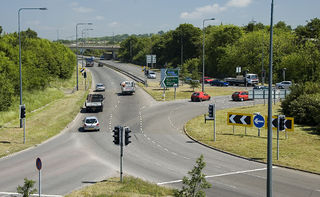
The A4174 is a major ring road in England which runs around the northern and eastern edge of Bristol, mainly in South Gloucestershire, and through the southern suburbs of the city. When it was first conceived it was planned to circle the whole of Bristol, and is commonly referred to as the "Avon Ring Road", or less accurately the "Bristol Ring Road", on road signs. The road does not circle the whole city, instead covering roughly half of the route. It is broken in part where it is concurrent with the A4.

State Route 227 is a state highway in the U.S. state of California and located in San Luis Obispo County. It is an alternate route of U.S. Route 101 between Arroyo Grande and the city of San Luis Obispo, serving the community of Edna and San Luis Obispo County Regional Airport. There is also an unconstructed routing from Route 1 south of Oceano to its present terminus in Arroyo Grande.
The Los Alamitos Traffic Circle, informally known as the Long Beach Traffic Circle, is a roundabout at the intersection of Lakewood Boulevard, Pacific Coast Highway and Los Coyotes Diagonal in Long Beach, California. The intersection was originally constructed as a traffic circle in 1930 and reconstructed as a modern roundabout in 1993.

An all-way stop – also known as a four-way stop – is a traffic management system which requires vehicles on all the approaches to a road intersection to stop at the intersection before proceeding through it. Designed for use at low traffic-volume locations, the arrangement is common in the United States, Canada, Mexico, South Africa, and Liberia, as well as in a number of, usually rural, locations in Australia where visibility on the junction approaches is particularly poor. The stop signs at such intersections may be supplemented with additional plates stating the number of approaches.
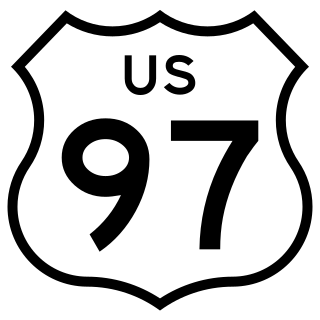
U.S. Route 97 (US 97) is a United States Numbered Highway, stretching from Weed, California to the Canadian border in Oroville, Washington. The California portion of US 97 runs north from I-5 in Weed to the Oregon state line. This is the majority of a shortcut between I-5 and Klamath Falls, Oregon, added to both states' state highway systems in 1931. It was designated as US 97 in 1935, replacing an east–west section in southern Oregon.

A protected intersection or protected junction, also known as a Dutch-style junction, is a type of at-grade road junction in which cyclists and pedestrians are separated from cars. The primary aim of junction protection is to make pedestrians and cyclists safer and feel safer at road junctions.

There is debate over the safety implications of cycling infrastructure. Recent studies generally affirm that segregated cycle tracks have a better safety record between intersections than cycling on major roads in traffic. Furthermore, cycling infrastructure tends to lead to more people cycling. A higher modal share of people cycling is correlated with lower incidences of cyclist fatalities, leading to a "safety in numbers" effect though some contributors caution against this hypothesis. On the contrary, Older studies tended to come to negative conclusions about mid-block cycle track safety.



















